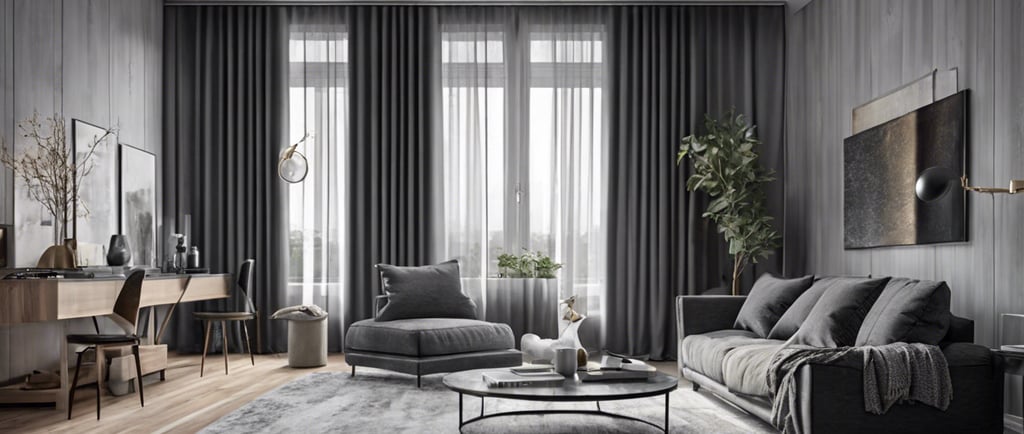The Ultimate Guide to Choosing Curtain Fabrics: From Style to Functionality
11/23/20245 min read


Understanding Different Curtain Fabrics
Curtain fabrics play a crucial role in enhancing the aesthetics and functionality of any room. Various types are available in the market, each offering unique textures, durability, and visual appeal. By understanding the different curtain fabrics, homeowners can make informed decisions that align with their design goals and functional needs.
Sheer fabrics are known for their lightweight and airy qualities. Often made from materials such as chiffon or organza, sheer curtains allow natural light to permeate a room while maintaining a degree of privacy. While they can create a soft and romantic ambience, sheer fabrics may not offer much in terms of insulation or light blockage.
Blackout fabrics stand in stark contrast to sheer materials. Typically crafted from tightly woven polyester or cotton blends, blackout curtains are designed to block out light completely. This makes them an ideal choice for bedrooms or media rooms where light control is paramount. Additionally, they can provide better insulation, helping to maintain temperature control within a space.
Linen is another popular curtain fabric, known for its natural texture and elegant appearance. It boasts breathability and a casual, sophisticated look, suitable for both modern and traditional interiors. However, linen does tend to wrinkle easily and may require regular ironing to maintain its aesthetic appeal.
Cotton is a versatile fabric that combines durability with a variety of patterns and colors. It is easy to care for and can withstand regular washing, making it a practical choice for high-traffic areas. Its adaptability allows it to fit various styles, from casual to formal. Polyester, on the other hand, offers durability, affordability, and resistance to wrinkles and fading, making it a widely used fabric for curtain production.
Finally, silk represents luxury in curtain fabrics. It provides a stunning sheen and rich texture that can elevate a room's elegance. However, silk often requires more care and can be susceptible to damage from sunlight and moisture, limiting its practicality.
In selecting curtain fabrics, it is essential to consider how each option aligns with personal style preferences and the desired ambiance of the space. Understanding the characteristics of sheer, blackout, linen, cotton, polyester, and silk can aid in making an informed choice that enhances both aesthetic and functional aspects of interior design.
Considering Style and Design
When selecting curtain fabrics, it is essential to consider the overall style and design of the space. The color palette of the room plays a crucial role in determining the appropriate fabric. For instance, if the walls are painted in neutral shades, opting for vibrant or patterned curtains can introduce a lively focal point. On the other hand, if the décor utilizes bold colors, choosing more subdued or matching tones for the curtains may create a harmonious flow, ensuring that no single element overwhelms the space.
Patterns and prints are also significant factors in fabric selection. Geometric patterns can add a modern touch, while floral prints evoke a sense of coziness and charm. Choosing the right print can enhance the aesthetic appeal of the room, making it vital to assess other elements present, such as the fabric of furniture or decorative accessories. For example, if the sofa features a busy pattern, it might be advisable to select solid-colored curtains to balance the visual stimulation. Conversely, mixing patterns can be quite effective if done thoughtfully, as long as a common color scheme is maintained.
Moreover, current design trends and timeless styles should both be taken into consideration. While it may be tempting to follow every new trend, incorporating classic designs can provide lasting elegance. Investing in fabrics that are both stylish and functional can contribute to a space’s long-term appeal. Ultimately, the selection of curtain fabrics should aim not only to reflect personal taste but also to foster an environment that is cohesive with the existing décor, thereby enhancing the overall room ambiance.
Evaluating Functionality and Practical Considerations
When selecting curtain fabrics, understanding their functionality is critical to ensure they meet the varied needs of your living spaces. Fabrics can significantly affect light control, insulation, and privacy, all of which are essential factors to consider depending on the room's purpose. For instance, lightweight materials such as sheer linens allow natural light to filter through, creating an airy atmosphere, ideal for living rooms or areas that benefit from sunlight. Conversely, heavier fabrics, like blackout curtains made from canvas or polyester blends, offer superior light blockage, making them suitable for bedrooms or media rooms where darkness is a priority.
Insulation properties are equally important when evaluating curtain fabrics. Thermal-lined options are designed to minimize heat transfer, keeping spaces cooler in summer and warmer in winter, effectively enhancing energy efficiency. These fabrics are particularly beneficial in rooms with large windows or poorly insulated areas. It is vital to consider how different fabrics perform against seasonal changes, as they can significantly impact your comfort levels and utility bills.
Privacy considerations should also guide your choice in curtain fabrics. In high-traffic areas or homes located close to neighbors, opting for thicker materials or lined curtains can ensure better privacy. Alternatively, lighter fabrics can provide some level of privacy while still allowing light to penetrate during the day. Furthermore, the maintenance and care required for different curtain fabrics should not be overlooked. Some materials are machine washable, while others may require dry cleaning, depending on their composition. Assessing your lifestyle, including how often your curtains will need to be cleaned, will inform your choice of fabric and its longevity in your space.
Making the Final Decision: Budget and Personal Preference
When selecting curtain fabrics, establishing a budget is essential. The cost of fabrics varies significantly, influenced by factors such as material, brand, and design complexity. Natural fibers like silk and linen often carry higher price tags, whereas synthetic options, such as polyester, tend to be more budget-friendly. Additionally, understanding the long-term implications of your choices can lead to better financial decisions. While a lower upfront cost may seem appealing, fabrics that are less durable might require more frequent replacements, ultimately increasing costs.
Another crucial aspect to consider is maintenance. Certain fabrics necessitate specialized cleaning, which can incur additional expenses over time. For instance, heavier drapes in materials like velvet or silk may require dry cleaning, leading to recurring costs that should be factored into your budget. On the other hand, fabrics like cotton or polyester can often be machine washed, making them more economical in the long run.
Beyond cost considerations, personal preference plays a pivotal role in the final decision. Curtains serve not just a functional purpose but also contribute significantly to a room's aesthetic. Reflecting on your personal style and the existing decor can steer you towards fabrics that harmonize with the overall ambience of your space. It is beneficial to gather samples of various fabrics and observe how they interact with the light in your room; this can provide a clearer picture of how different textures and colors will look in your environment.
Numerous resources are available for purchasing curtain fabrics. Local fabric stores often provide a wide range of options, while online retailers grant access to a diverse selection. Evaluating both options can help in identifying the ideal fabric that meets your budgetary and stylistic requirements. Ultimately, balancing your financial constraints with your personal taste will facilitate a satisfying choice in curtain fabrics.
Curtains&Fabrics
Design,production,sales,service in curtain fabrics&curtians.
Quality
Products
sales01@anytextile.com
+8615968501933
© 2024. SHAOXING LEYAO IMPORT AND EXPORT CO.LTD All rights reserved.
